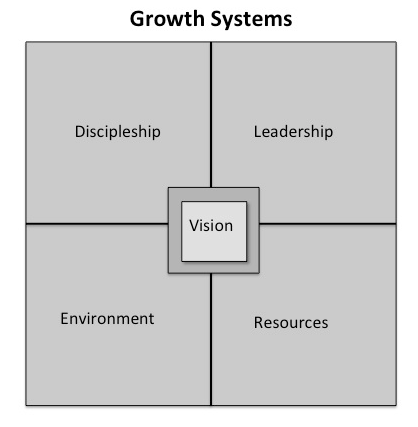
12 Fun Facts About the Vision Frame for Church Leaders
What is the Vision Frame? I’m glad you asked. It is a simple napkin sketch or whiteboard drawing that is used to represent the five irreducible questions of any ministry. It pictures mission, values, strategy, measures and vision and relates them in a way that is more meaningful and memorable. Read the complete overview.
For now here are some fun facts about the Vision Frame which debuted in print in the book Church Unique: How Missional Leaders Cast Vision Capture Culture and Create Movement.
1- BIRTHPLACE: The Vision Frame was born on a napkin sketch in 2001, in Clear Lake, Texas when I was playing and doodling at my desk. It is now 14 years old and sometimes wakes up with pimples.
2- CHEAP LABOR: When the Vision Frame first hit the road consulting, I was simply begging my seminary buddies to bring me in for staff retreats. I would come as long as they paid my airfare and bought lunch.
3- BILINGUAL: The Vision Frame speaks two languages— it can enter a meeting on classic planning and hangout in the missional conversation. This language roughly corresponds to leaders over 40 years of age (classic lingo) and leaders under 40 (missional lingo). In other words, the Vision Frame is proud to be multigenerational tool.
4- PERSONALITY: The Vision Frame is notoriously hard to get to know and even comes across square at first. But once you get to know it, it becomes a best friend that you will always want around.
5- NO FAVORITES: Since the Vision Frame is truly model neutral, its works for any faith tribe, ministry model or philosophy. It loves church planters, turnaround leaders, and megachurch pastors just the same. It truly has no favorites!
6- HAPPIEST DAY: Anytime a church leaders go up to a white board and shares the five irreducible questions of clarity around a box, square or anything that remotely looks like a Vision Frame.
7- SADDEST DAY: When the Vision Frame read Tim Keller’s Center Church and it was never mentioned. It’s feelings were hurt since so many books in the missional conversation where mentioned both good and bad. After all, how can you talk about “theological vision” without a Vision Frame?
8- TRACK RECORD: Church leaders search for “Vision Frame” 400 times per month on the internet; it sells the same number of books per month after 8 years.
9- TRAVEL: The Vision Frame has spent the most of its travel time all over South America, Korea, Germany and Switzerland. The Spanish version is Iglessia Unica. The Korean version of Church Unique is literally translated, “Your Church in 10 Years.”
10- SECRETS: The Vision Frame secretly believes that when Jesus was drawing something in the sand, it was probably looked like a frame.
11- STYLE: The Vision Frame is the only organizational approach to clarity that actually uses a picture to transmit the key ideas. Patrick Lencioni, Jim Collins and Peter Drucker have similar irreducible questions but never made them visual or fashionable. Furthermore the Vision Frame has icons decorating it and a 52-page gorgeously designed visual overview dedicated to it. Get it here—requires e-mail.
12- KISSIN COUSIN: The Vision Frame has a related tool, the Horizon Storyline, which debuts on January 1st of 2016: God Dreams: 12 Vision Templates to Find and Focus Your Church’s Future. While the Vision Frame will be a little jealous there are many shout outs to it in the book.
Would you like to know more about the Vision Frame? Connect with an Auxano Navigator and start a conversation with our team.

Tags: Church Unique, God Dreams, Vision Frame, Will Mancini, auxano
































